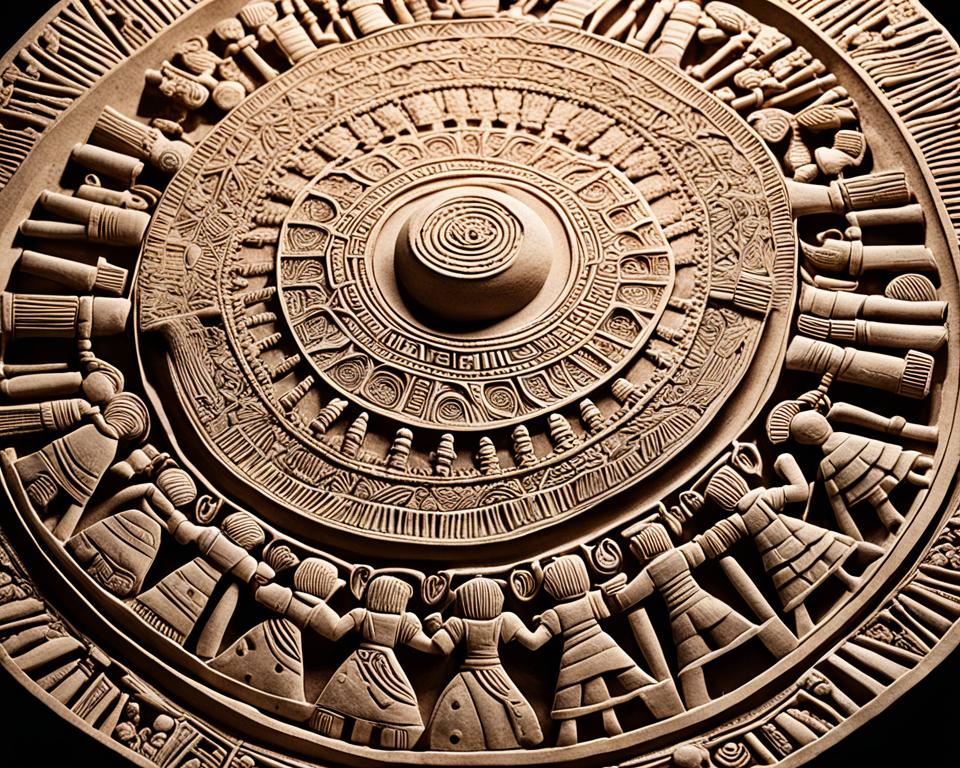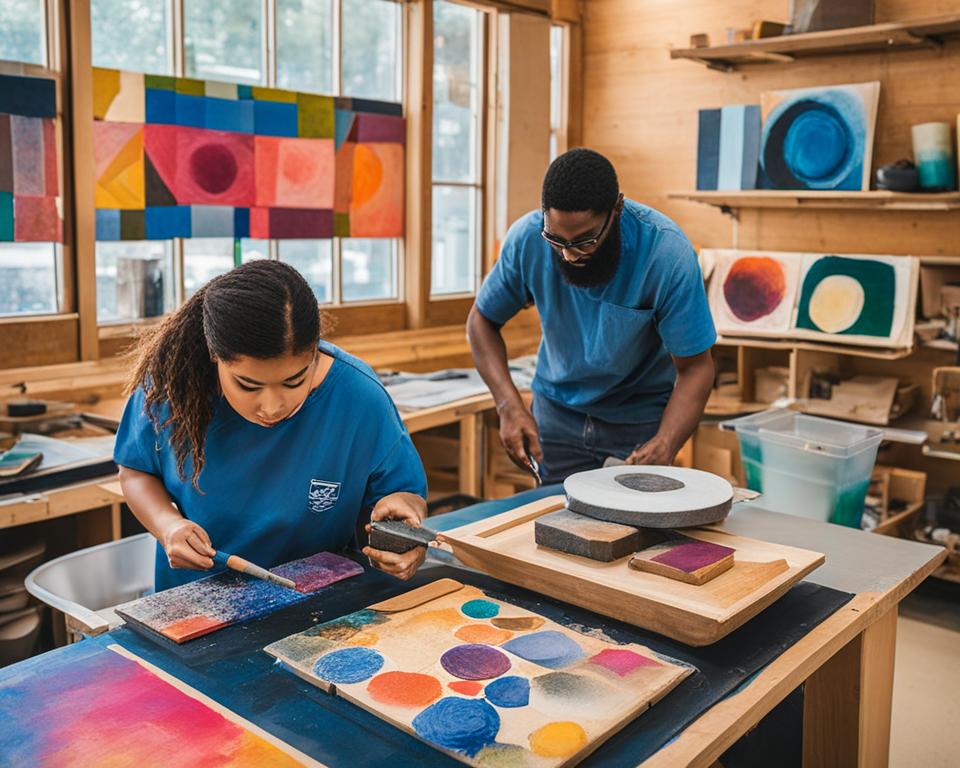Welcome to our comprehensive guide on printmaking as an artform! In this fascinating journey, we will delve into the world of printmaking, its rich history, and its significance in the contemporary art scene. From ancient techniques to modern innovations, printmaking continues to captivate artists and enthusiasts alike. So, whether you’re a seasoned printmaking artist or someone simply curious about this intriguing medium, this guide is here to provide you with valuable insights and inspiration.
Exploring Printmaking as an Artform: A Guide

Key Takeaways:
- Printmaking is a diverse and versatile artform that encompasses various techniques and processes.
- Understanding the history of printmaking helps us appreciate its enduring influence on the art world.
- Printmaking classes and workshops provide opportunities for aspiring artists to learn and hone their skills.
- Printmaking galleries and art shows showcase the vibrant creations of printmaking artists.
- Whether you’re an artist or an art enthusiast, exploring printmaking opens up a world of creativity and expression.
St. Louis Printmaking Artist
Understanding Printmaking: What Is It?
In this section, we will explore the fascinating world of printmaking and delve into its various techniques. Printmaking is a versatile artform that involves creating multiple impressions or copies of an image or design. Unlike traditional drawing or painting, which result in unique original artworks, printmaking allows artists to produce multiple prints from a single plate or surface.
Printmaking encompasses a wide range of techniques, each with its own unique characteristics and processes. Let’s take a closer look at some of the most popular types of printmaking:
Relief Printing
Relief printing is a technique where the artist carves away the negative space of an image on a block or plate, leaving the raised areas to be inked and printed onto paper. This includes woodcut, linocut, and wood engraving. Relief prints are known for their bold and graphic aesthetic, with each print bearing the distinct texture and marks left by the carving tools.
Intaglio
Intaglio printmaking involves incising or etching an image onto a plate, typically made of metal or acetate, and then transferring the inked image onto paper using a press. Examples of intaglio techniques include engraving, etching, and drypoint. Intaglio prints are characterized by their precise lines, rich tonal range, and intricate details.
Lithography
Lithography is a planographic printmaking technique that uses the principle that oil and water repel each other. The St. Louis artist draws or paints an image on a smooth surface, typically a limestone or metal plate, using a greasy medium. The plate is then inked, with the ink adhering only to the greasy image, and transferred onto paper through a press.
Screenprinting
Screenprinting, also known as silkscreen printing, involves creating a stencil on a fine mesh screen and then using a squeegee to push ink through the open areas of the stencil onto the paper. This technique allows for vibrant colors, detailed patterns, and the possibility of printing on a variety of surfaces, including fabric, paper, and even wood.
By understanding the fundamentals of each printmaking technique, we can gain a deeper appreciation for the artistry and skill that goes into creating these unique works of art. Now that we have explored the basics of printmaking, let’s continue our journey by tracing its fascinating history in the next section.
Tracing the History of Printmaking
As we explore the captivating world of printmaking, it is essential to understand its rich history. From its origins in ancient China to its prominent role in the Renaissance period and beyond, printmaking has evolved and flourished over centuries.
The journey begins in ancient China, where the art of printmaking first emerged. In the Tang Dynasty (618-907 AD), woodblock printing became a widely practiced technique, primarily used for reproducing Buddhist texts and images. The development of papermaking and the invention of movable type enhanced the accessibility and efficiency of printmaking.
Europe witnessed the Renaissance, a period of intellectual and artistic advancement that profoundly influenced the art world. Printmaking played a significant role during this period, thanks to technological advancements such as the invention of the printing press by Johannes Gutenberg in the 15th century. This revolutionary invention enabled the mass production of books, disseminating knowledge and artistic ideas across Europe.
The Renaissance printmaking masters, including Albrecht Dürer and Rembrandt van Rijn, elevated the status and techniques of printmaking, pushing the boundaries of artistic expression. Engraving, etching, and drypoint became popular techniques, allowing artists to create intricate, detailed, and expressive prints.
During the 19th and 20th centuries, printmaking continued to evolve as artists experimented with new techniques and embraced artistic movements such as Impressionism, Expressionism, and Surrealism. The advent of lithography and the rise of artists like Honoré Daumier and Henri de Toulouse-Lautrec brought new dimensions to the artform.
Today, printmaking remains a vital and dynamic artform, embraced by artists in St. Louis, and worldwide. Its historical significance and diverse techniques continue to inspire contemporary artists, who push the boundaries of the medium with their innovative approaches.
Inspiring Quote
“Printmaking offers a rich tapestry of techniques and artistic possibilities, allowing artists to create unique and compelling visual narratives.” – Jane Miller, Printmaking Artist
Understanding the history of printmaking provides a deeper appreciation for the artform and its enduring influence on the art world. Let’s now explore the contemporary printmaking scene to see how this ancient practice thrives in the modern era.

| Period | Key Developments |
|---|---|
| Ancient China | Origins of woodblock printing and movable type |
| Renaissance | Introduction of the printing press and advancements in techniques |
| 19th and 20th Centuries | Exploration of new techniques and influence of artistic movements |
Exploring Printmaking in the Art World Today
In this section, we will dive into the contemporary printmaking scene. We will explore the opportunities for aspiring printmakers to learn the craft through printmaking classes and workshops. Additionally, we will highlight the role of printmaking galleries and art shows in showcasing the vibrant and diverse creations of printmaking artists today.
For those looking to develop their printmaking skills, enrolling in a printmaking class can provide invaluable guidance and instruction. These classes offer a structured learning environment where participants can gain hands-on experience with various printmaking techniques. From relief printing to screenprinting, students will have the opportunity to explore different methods and find their unique artistic voice. By learning from experienced printmakers, individuals can hone their craft and expand their artistic horizons.
Printmaking Classes: Where to Start
If you’re eager to join a printmaking class, there are numerous options available. Many reputable art institutions, community centers, and universities offer printmaking courses taught by experienced instructors. These classes cater to both beginners and more advanced artists, ensuring that participants can find a suitable level of instruction based on their skillset.
Remember to search for printmaking classes in your local area or online, using platforms like Coursea and Udemy that offer a wide range of art courses.
Additionally, printmaking workshops provide a condensed and focused learning experience for both established printmakers and beginners alike. These workshops are often led by renowned printmakers, who share their expertise and insights with a small group of participants. Through intensive hands-on sessions, attendees can deepen their understanding of specific printmaking techniques and refine their skills in a supportive environment.
The Role of Printmaking Galleries and Art Shows
Printmaking galleries in St. Louis play a vital role in promoting and exhibiting the work of printmaking artists. These dedicated spaces provide a platform for artists to showcase their creations, connecting them with art enthusiasts and potential buyers. Printmaking galleries often curate exhibitions that focus on specific themes or techniques, creating a cohesive narrative that highlights the diversity and creativity within the printmaking world.
“Printmaking galleries act as gatekeepers for the printmaking art community. Their exhibitions shed light on emerging artists, as well as established talents, fostering a sense of community and appreciation for this unique art form.”
– Jane Adams, Curator at the Printmaking Gallery of New York
Art shows and fairs also offer valuable opportunities for printmaking artists to showcase their work to a broader audience. These events attract art collectors, gallery owners, and art enthusiasts who are eager to discover new and exciting talent. By participating in art shows, printmaking artists can gain exposure, build their network, and even secure sales or commissions for their artwork.

Conclusion
In conclusion, this comprehensive guide has taken you on a captivating journey through the world of printmaking art. We have explored its fascinating history, delved into the various techniques involved, and examined its enduring relevance in the contemporary art world.
Printmaking art offers a unique aesthetic and unparalleled versatility that continues to captivate artists and art enthusiasts alike. From relief printing to intaglio, lithography to screenprinting, each technique showcases the meticulous craftsmanship and artistic vision of printmakers.
Whether you are an aspiring printmaking artist or a passionate admirer of the medium, we hope this guide has deepened your understanding and appreciation for printmaking art. It is a medium that allows for endless creativity, self-expression, and the ability to evoke meaningful emotions through intricate details and rich textures.
As the art world evolves, printmaking art prevails as a testament to the enduring power and beauty of craftsmanship. So, embrace the world of printmaking art, explore its diverse possibilities, and join the ranks of esteemed printmakers in shaping the ever-evolving art landscape.
FAQ
What are the different types of printmaking?
Printmaking encompasses various techniques, including relief printing, intaglio, lithography, and screenprinting. Each technique offers its own unique characteristics and creative possibilities.
How can I learn printmaking?
There are numerous opportunities to learn printmaking, including printmaking classes and workshops. Many art schools and institutions offer courses that cater to beginners as well as more advanced printmakers.
Where can I view printmaking art?
Printmaking galleries and art shows are excellent venues to appreciate and explore the world of printmaking art. These spaces often showcase the works of established and emerging printmaking artists, providing a diverse range of styles and techniques.